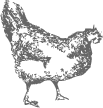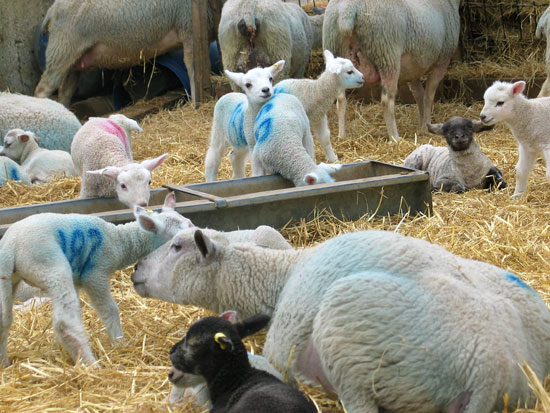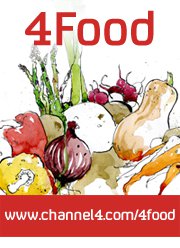
All this talk of eating locavore and buying food at the local farmers market is making me feel like a better shopper but I’m still self-conscious that I only have fairly basic grasp on how farming works, especially when it comes to keeping animals. Should I buy the sustainably farmed local meat, or the organically certified lamb from a few hundred miles away? I like the reassurance of buying from a certified producer but also like to think that if I buy meat from a small local producer then animals will have been well looked after and subjected to minimal stress from travelling. In the end the only way to know for sure would be to go and check it out for myself. I’m not really the sort of person to ring up my local farm and ask if I can pop round for a up of tea and a nosey, but happily this time I didn’t need to because the lovely people selling Northmoor Trust lamb at Oxford Farmers Market were inviting people round themselves, for their annual open lambing weekends.
The Northmoor Trust is the custodian of nature reserve that surrounds the Wittenham Clumps, a series of iron age hill forts near Wallingford in Oxfordshire. These have apparently known in the past by much more colourful names like “Berkshire Bubs” and “Mother Dunch’s Buttocks”! The clumps are curved grassy mounds topped by little tufts of beech tree – think how a hill looks as drawn by a five year old (I like this picture on flickr). The surrounding land is part nature reserve, part sustainable farming experiment, researching and promoting methods of farming that improve animal welfare and look after the environment, while still being economically viable (plenty to keep them busy there then!). Sustainable is the important word in the case of Northmoor; this farm is not organic but instead aims to “enhance the economic, social and environmental fabric of the countryside”.
You can see from the picture that these are some pretty happy looking lambs (the mums looked pretty contented too, in case you were wondering). All in all there was quite a sociable nursery atmosphere to the place, with the kids able to socialise together while the mums had a chat and a bite to eat.
The only slightly (completely unncessarily) anxious moment I had was when I saw a row of ewes and lambs in pens where the ewes had their heads through railings. They weren’t uncomfortably tight but were obviously designed so that they couldn’t turn round to rub noses with the little ‘uns. There was no reason for even a blip of anxiety; this was the fostering area, matching ewes who had lost their lambs with those babies who had either lost their mother or who had far too many brothers and sisters to compete with for milk. Keeping the ewes from smelling the lambs for the first few days of fostering is apparently the best way of making sure that both parties get to know each other without any grounds for rejection on account of not smelling right (you can see a couple of happy foster twins below).
This type of sustainable farming ticks all of the big boxes that usually lead me to buying organic meat:
– The lambs live in pleasant, uncrowded conditions before being living outdoors on responsibly farmed pasture
– They aren’t given excessive and unnecessary amounts of medication. Unlike organic certified animals these lambs are given vaccinations but Northmoor believe that this justifies itself in the reduced amount of antibiotics needed later.
– No spooky, unidentifiable foodstuffs eaten around there; the lambs are fed on peas, barley and hay grown at the farm using integrated farming techniques designed to increase wildlife
-When the time comes they are slaughtered locally, a far cry from the many sheep we send to the continent on stressful trips in crowded transporters.
While not wanting to belittle the achievement of those farms who have gone through the tough organic certification process, I’m more than happy with these standards. If you buy organic meat for the same kind of reasons that I’ve just talked about its definitely worth considering sustainably farmed lamb as an alternative if you see it. The very nature of sheep farming on land such as hill and moors can make organic certification an unrealistic (or even undesirable) aim for some small producers. If you are an avid purchaser of organic meat I’d really recommend looking at Ruth Watkins open letter to the Soil Association suggesting the need for a different certification scheme for this kind of farming (she brings up lots of issues about organic farming and animal welfare that I really hadn’t heard about or thought about).
If you live in the Oxfordshire area I would highly recommend going to next year’s lambing weekends. If you time it really well (we didn’t) you might even see a lamb being born. There were loads of families there and it’s a great way to get children thinking about where their food comes from while having a bit of fun. And the meat? The lamb from Northmoor is fantastic and you can buy some slightly more unusual cuts like breast of lamb. I thought about posting my recipe for their breast of lamb at the bottom of this piece but I wasn’t sure if people would find it offensive after all the pictures of fluffy baby lambs. I hope you wouldn’t if you’ve stuck with me this far, but just in case, and to give you a reading break I’ve put the recipe part in a second post.


 Come join me on Twitter
Come join me on Twitter Sophie Roberts is a registered dietitian based in Oxford, UK. She loves combining her nutrition know-how with a sustainable approach to buying and preparing food and shares her tips and recipes here at Mostly Eating.
Sophie Roberts is a registered dietitian based in Oxford, UK. She loves combining her nutrition know-how with a sustainable approach to buying and preparing food and shares her tips and recipes here at Mostly Eating. 
{ 2 comments }
Very interesting post indeed. And oh, terrible to say (because I love lamb), they look so cute….
Thanks for this info ! Kisses.
——————————–
Tableau vegetal